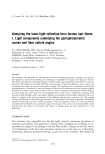j. Cosmet. sci., 54, 283-288 (May/June 2003) A comparison of the mosquito-repelling efficacy of methyl neodecanamide (IVINDA) to that of Deer THOMAS G. POLEFKA, LI-JUNG LIANG, and TARACAD NARAYANAN ANANTHAKRISHNAN, Co/gate-Palmolive Company, 909 River Road, Piscataway, NJ 08854 (T.G.P., L.L.), and Entomology Research Institute, Loyola College, Madras-600 034, India (T.N.A.). Accepted for publication July i, 2002. Synopsis The objective of this small pilot study was to assess the mosquito-repelling efficacy of methyl neodecana- mide (MNDA) relative to N,N-diethyl-3-methylbenzamide (Deer) against Anopheles stephensi, Culex quin- quefasciatus, and Aedes aegypti under controlled laboratory conditions. In this study, subjects inserted both forearms (sham- and repellent-treated) into a test chamber containing 50 female mosquitoes. The number of mosquitoes landing on or probing each forearm during the 5-minute "forced-choice" test session was recorded each hour for a total of eight hours. Effectiveness was calculated according to Abbott's formula. Experimental results indicate that topical application of 1% MNDA provided significantly better protection and a broader spectrum of repellency than application of 1% Deer against the three species of mosquitoes. These promising results support further study of MNDA as a topical mosquito repellent. INTRODUCTION In some parts of the world, biting insects are nothing more than an annoyance to individuals involved in outdoor activities (1). However, in other parts of the world, mosquitoes and flies represent a major health concern since they are key contributors to the spread of serious diseases such as malaria, filariasis, dengue fever, leishmaniasis, and trypansomiasis (2). Currently, N,N-diethyl-3-methylbenzamide (Deer) is the most effective and widely used topical insect repellent (3). However, excessive application of this popular insect repel- lent by consumers may result in serious adverse health effects, such as disorientation, toxic encephalopathy, insomnia, and irritability (4). Indeed, several cases of death have been reported (5). In spite of these adverse reactions, it is unlikely that Deer will be withdrawn from the marketplace anytime soon. Recently, methyl neodecanamide (MNDA) was shown to be a highly effective cockroach repellent (6,7). Because MNDA and Deer are chemically similar (i.e., both are secondary amides), we decided to assess the mosquito-repelling efficacy of MNDA (relative to Address all correspondence to Thomas G. Polefka. 283
284 JOURNAL OF COSMETIC SCIENCE Deet) under controlled laboratory conditions against Anopheles stephensi, Culex quinque- fasciatus, and Aedes aegypti. MATERIAL AND METHODS Reagent-grade Deet and isopropyl alcohol were purchased from Aldrich Chemical Com- pany (St. Louis, MO). MNDA was prepared by Parrmal Industries (Cuernavaca, Mexico) according to the method described by Steltenkamp et al. (6). EXPERIMENTAL Uninfected A. stephensi, C, quinquefasciatus, and A. aegypti were employed in this study. The eggs were hatched, and larvae were reared in muslin-covered plastic trays (50 cm x 19 cm x 15 cm) containing fresh tap water supplemented with a mixture of yeast and dog biscuit. This mixture was changed daily. Pupae were transferred with the aid of a dropper to plastic boxes covered with mosquito netting. Upon emerging, the male mosquitoes were removed and the female mosquitoes were maintained on a diet of 10% sucrose for 4-10 days. Feeding was suspended 24 hours prior to the start of the test. After giving informed consent, eight healthy adult males (ages 26-56 yrs) were enrolled in the study. However, because only four mosquito test chambers were available for each test session, only four subjects participated on a given test day. For convenience, one species of mosquito was bred at a time and used to complete the evaluation of both repellents. Three separate test sessions, separated by a two-day washout period, were used for each repellent. Finally, to prevent the repellents from interfering with each other, only one repellent was tested during a test session. To establish a uniform level of cleanliness, the volunteers washed their hands and forearms for one minute with unfragranced soap. The experiment was initiated when a gloved assistant applied 2 ml of the insect repellent (1% Deer or MNDA in isopropyl alcohol) to a randomly assigned hand/forearm and distributed it over the entire skin surface. The contralateral hand/forearm received the vehicle. After ten minutes (to permit evaporation of the isopropyl alcohol), each volunteer inserted his hands into a test chamber (31 cm x 31 cm x 31 cm) containing 50 nulliparous, 4-10-day-old, female mosquitoes (8). A different assistant, unaware of treatment assignments, recorded the number of insects landing/probing per five-minute test session. However, to prevent the mosquitoes from completing their feeding, they were shaken off (8). Once every hour, for a total of eight hours, the hands and arms were re-inserted into the insect chamber and exposed to the insects for five minutes. Between the challenges, the volunteers were permitted to perform light clerical duties but were restricted from washing their hands. Following the completion of each eight-hour test, the volunteers washed their hands/ forearms with soap to remove residual insect repellent. Since the three mosquito species exhibit vastly different feeding schedules (9), the experiments were conducted during species-specific peak feeding periods, namely, 18:00 for A. stephensi, 20:00 for C. quinquefasciatus, and 07:00 for A. aegypti. Although A. stephensi is recognized as a nocturnal feeder (9), the species used in this study was crepuscular, showing marked activity at dusk. Similar findings were reported by Reisen and Aslamkham (10) for Ao stephensi in Pakistan.
Purchased for the exclusive use of nofirst nolast (unknown) From: SCC Media Library & Resource Center (library.scconline.org)


























































































